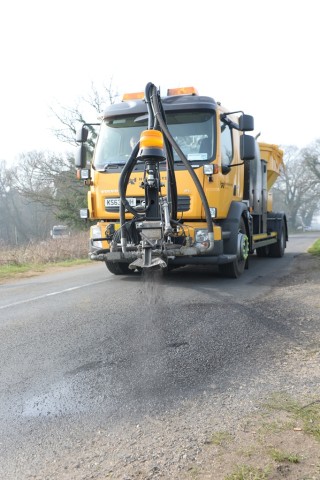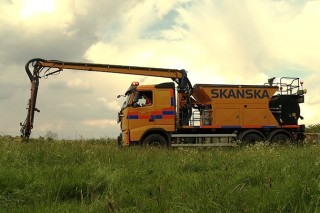Will the future of highways maintenance involve robots more than people? Contractors and plant manufacturers have been working on innovations to improve the road repairs process – and the most futuristic example of late is Amey’s ‘robot’.
As first reported in April, the firm has invested £500,000 on two road patchers (which it claims can fix potholes in two minutes) plus a high-speed sweeper, for its maintenance contracts. The machines are currently working on Amey’s asset support contracts for the Highways Agency in East Anglia and eastern England.
The road patcher machines, which were custom-built for Amey, can be fully controlled from the cab. The driver operates a robotic arm which extends from the cab over the pothole and fills it with material to fix the hole.
The Brodd Europa high-speed sweeper, which sweeps at 20km/h, is also new to the UK.
However, Amey is not alone. Skanska is also trying to bring Swedish thinking to the UK with another cab-controlled patching machine.
Skanska's patcher uses hot bituminous emulsion, which binds well with the existing road. There is also a flame heater at the front for use on colder days to provide extra heat. Skanska has been trialling the machine on four of its road maintenance contracts and is now evaluating the results.
“The trial went very well,” says Gregor Craig, Skanska’s infrastructure services managing director. “Speed is the main advantage - it takes two minutes per hole. The machine is best used in a preventative approach - dealing with small damaged areas before they become proper potholes. “It is much safer as there is no need for a gang on the road. The process is controlled entirely by just one operator in the cab.” Craig says Skanska is “working out the economics” of bringing more machines over to the UK, but adds he “would be very surprised if we don’t start using them more widely.”

Another Swedish creation which has helped highways maintenance crews in Scandinavia – though is less common in the UK – is the tiltrotator excavator attachment. This allows greater scope of movement without the need to move the base machine thus making tricky utilities excavating work quicker, more efficient and safer. Jobs that might normally be done by hand can be performed from the cab. Pat Bulcock, UK managing director of manufacturer Engcon, says: “Based on tiltrotator usage in Sweden, experienced excavator drivers estimate the productivity increase to be somewhere between 10% and 25%.”
Another innovation is JCB’s new ‘Potholemaster’, based on its backhoe loader. Equipped with a planing attachment at the rear, the machine grinds away the surface of the pothole and surrounding road and then drives backwards and forwards, sweeping up the loose material before repairing the hole with blacktop.
Caterpillar’s UK dealer Finning believes greater technological sophistication will improve the efficiency of the highways maintenance process further. Robert Doble, paving product manager at Finning, says: “We have historically relied heavily on the skills of the operators of compaction and asphalt equipment. But it has traditionally been very difficult to gauge whether the right level of compaction has been achieved without manual testing. More often than not an additional pass is done just in case, generally for peace of mind.
“Through the launch of the latest models - compactors in particular – we can deliver relevant performance information to the operator. This has been made possible thanks to key advances in telemetry and onboard systems connected to sophisticated sensors.”
Caterpillar’s answer is ‘Cat compaction control’ which allows the operator to see when an area has been fully compacted and when to stop working. “From field tests carried out on motorway-style roads in America, this technology allowed the operator to reach the required compaction level in 75% less time than it took using previous methods,” Doble says.
This article first appeared in the July 2014 issue of The Construction Index magazine, which can be viewed in full at: http://epublishing.theconstructionindex.co.uk/magazine/july2014
While the magazine is free to view online, a subscription is required to receive you own hard copy every month. This can be purchased for just £35 a year at http://www.theconstructionindex.co.uk/magazine
Got a story? Email news@theconstructionindex.co.uk





